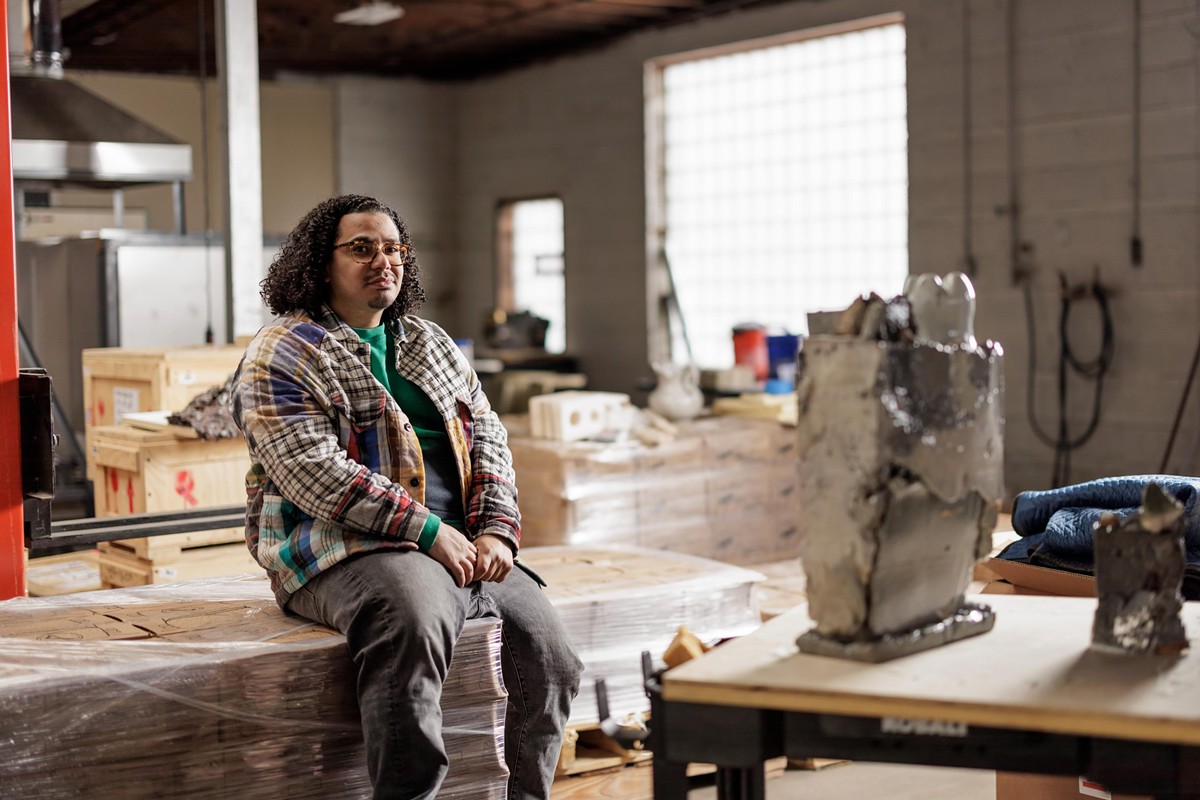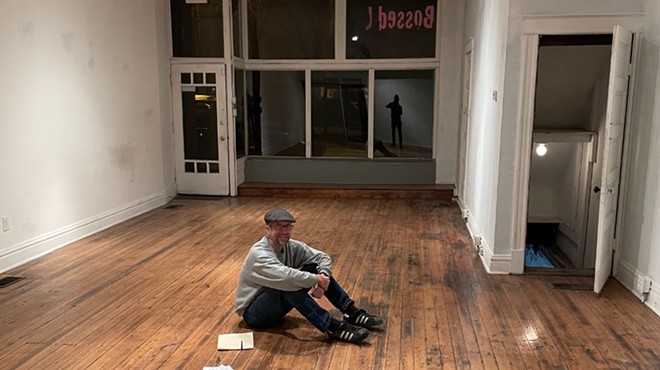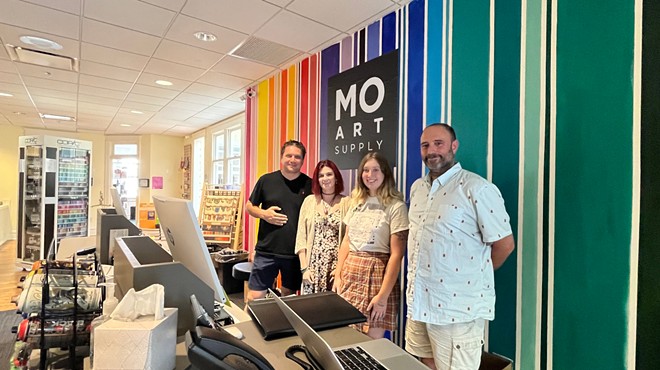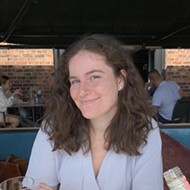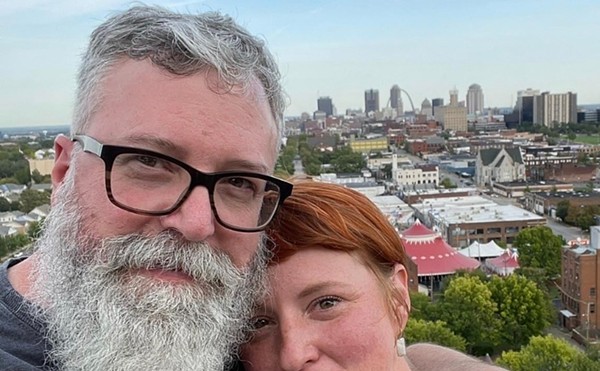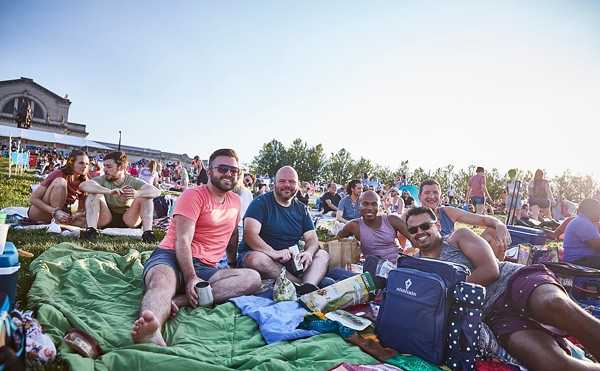In the center of the Mildred Lane Kemper Art Museum’s Ebsworth Gallery stands a 2,500-square-foot plywood platform. A wide set of stairs forms one side of the perimeter, while an Americans with Disabilities Act–compliant ramp lines another — Irving is adamant that “people who navigate space in all ways possible” have access to the experience.
Within the platform lie eight distinct elements — well, some of them lie. Others tower overhead, or perch atop chipwood pedestals at eye level, or sit sunken into the platform itself, enclosed by low railings. The installation resembles an archaeological excavation, where the Doric columns of Pompeii give way to a ceramic industrial pipe or fragment of faux-brick wall, while the subterranean gaps reveal not Byzantine mosaics, but stoneware tiles that mimic the asphalt of a city street.
“I'm just reflecting on the built world as an entity, as a place, as a fiction,” Irving says.
“These things tell part of this kind of fragmented story of a space or people or the time,” says Meredith Malone, curator at the Kemper. “I think the whole thing is stunning.”
This is not Irving’s first show at the Kemper. As a graduate student at Washington University’s Sam Fox School of Art and Design, Irving’s work, alongside that of 24 classmates, was displayed in the museum’s Ebsworth Gallery as part of its 2017 MFA Thesis Exhibition. His installation featured two large sculptures, a digital Jacquard weaving and three flags — elements that have frequently reappeared in Irving’s subsequent work. In many ways, Irving sees that exhibition, though smaller in scale, as a “precursor” to Archaeology of the Present.
For Irving, the return to Wash U is a cause for celebration, despite his fraught relationship with the Sam Fox School — specifically, with its mostly white faculty.
“A lot of the faculty have their feelings hurt, because they're all uncomfortable being around me, because they're afraid of being held accountable for their bad behavior,” says Irving, though he declines to be more specific. “I hope that the exhibition can be as much of a celebration as I’d like it to be. Like, I hope that despite the racist, problematic infrastructure of Washington University's Sam Fox School, that the faculty can support and appreciate the hard work and determination that I have had to become and be a successful alumni of the University and in the art world.” (Wash U did not respond to a request seeking comment.)
Irving’s “successful alumni” status is hardly in question. When the Riverfront Times last profiled Irving, in 2016, he was still at Wash U. Since then, Irving has participated in exhibitions at the Gagosian Gallery in London, the New Museum and the Museum of Modern Art, to name a few. You can find him in the permanent collections of institutions like the Carnegie Museum of Art, the RISD Museum and the Whitney Museum of American Art. Irving’s creations have traveled as far as the Riga Porcelain Museum in Latvia and the Foundation for Contemporary Ceramic Art in Hungary, and as close to home as the Contemporary Art Museum St. Louis.
Most recently, his work was the subject of the Walker Art Center’s original presentation of Archaeology of the Present in Minneapolis.
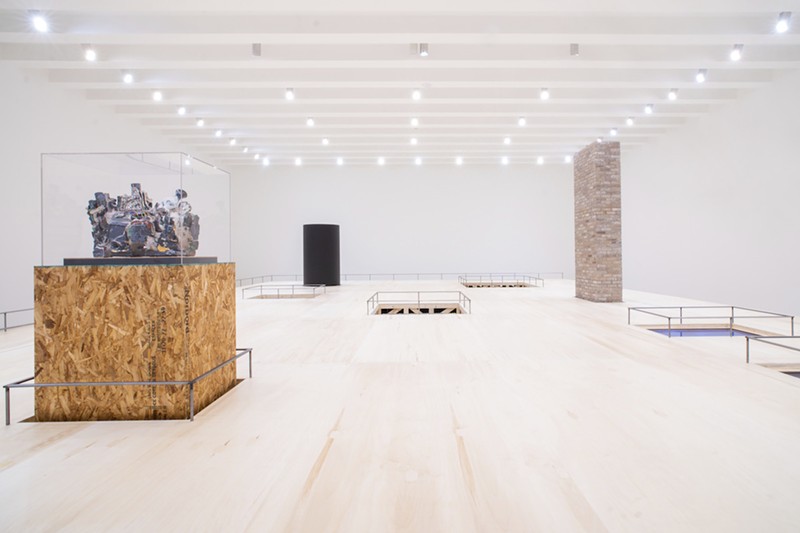
COURTESY PHOTO VIA THE KEMPER
Archaeology of the Present was presented in Minneapolis before making its way to St. Louis.
“He's always been incredibly ambitious and really thoughtful in the kind of work that he was producing,” says Malone, who curated the 2017 MFA exhibition. “You can see how hard he works and the vastness of his approach to creative making.”
In some ways, Irving’s approach to making is surprisingly straightforward: “I like making shit. I like making weird shit. I like making new shit,” he declares emphatically when asked where he draws his inspiration from.
At the same time, Irving, who describes himself as a “critical person,” has found in his art a powerful vehicle for self-expression and social commentary.
“I’ve always known I had something to say,” Irving says. “Making sculpture and making paintings and making exhibitions has just been one way that has been able to be realized.”
In Archaeology of the Present, Irving says a lot. The city street “as both place and concept” is central to the exhibition and to the artistic ethos of Irving, who grew up and resides in south St. Louis.
“A lot of his work is grounded in his experiences here, in this city, and this social and environmental context,” says Malone. “He's always thinking about the city street. He's thinking about that as a public space, but also a place of violence.”
In one work, Flat Smoke [{my heart is and ain’t heavy}|Can we remember MS Green!], ceramic facsimiles of crumbled newspapers litter a floor of jet-black glazed tiles, evocative of the city street. The publications imitated range from historically Black publications to the St. Louis Post-Dispatch and the New York Times. They relay acts of violence, advertise social gatherings or display graphs of COVID-19 mortality rates.
“Each fragment of the installation, each section of the installation, is just a moment: the moment caught in ecstasy, the moment caught in joy, in mourning,” Irving says. “There are references to specific life experiences or symbols that relate to, that open up the dialogue for many people, or open up space for many people to feel seen or recognized in the work.”
The exhibition welcomes all viewers to reflect on these moments, but not every viewer will feel “seen” in the same way.
“The installation is just the presence of a series of optics to imbue or engage with ideologies,” Irving says. “There's a bridge that has to be built to address that. To approach that bridge, you already have to be doing the work of dealing with your relationship to white supremacy and violence.”
The Kemper’s presentation of Archaeology of the Present will introduce five new works from Irving, including a flag and a four-part painting — a relatively new medium for him. In tandem with the exhibition, the Kemper Museum Video Gallery will screen seven short films selected by Irving, many of which were created by former fellow MFAs or local St. Louis artists.
“He's very much interested in bringing people along with him too,” Malone says.
Archaeology of the Present opens February 23 and will run through July 29. For more information, visit the Kemper Art Museum's website.
Subscribe to Riverfront Times newsletters.
Follow us: Apple News | Google News | NewsBreak | Reddit | Instagram | Facebook | Twitter | Or sign up for our RSS Feed

